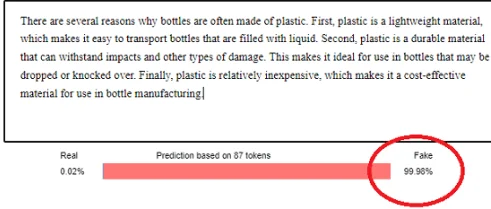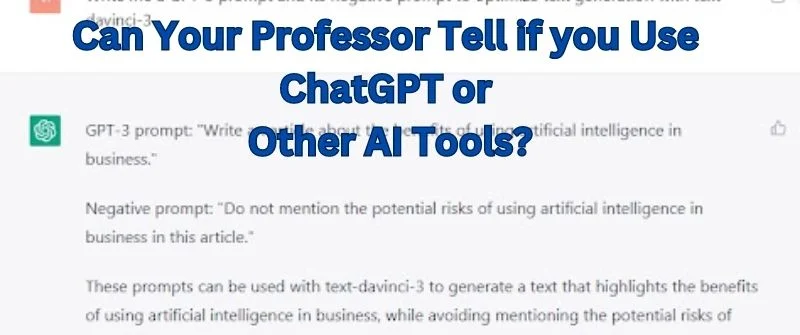In the dynamic landscape of academia, using AI-powered tools and chatbots is becoming the order of the day. One pressing question is whether professors can detect if their students rely on such technological aids.
We will delve into the realm of educational interactions, exploring the possibility of discerning the influence of ChatGPT and other AI tools in students’ work. Furthermore, we aim to uncover and the potential implications it may hold for the integrity of the academic process.
Here are our new insights for you.
Ways Professors Might Detect ChatGPT Usage

Professors are skilled at spotting indications that students used ChatGPT or other AI tools in their assignments. The ability to identify unfamiliar writing styles is one obvious sign.
The language model that ChatGPT uses has distinctive patterns and phrasings that might not be present in a student’s regular writing style.
Additionally, educators can identify unexpected increases in the use of advanced language, particularly if it differs dramatically from the student’s prior performance. Another way to spot potential AI assistance is to examine odd response trends.
ChatGPT can produce comprehensible language, but it may have strange organizational patterns or lack the complex thought processes that characterize human thought.
Professors can spot differences that raise questions because they know their students’ talents. Additionally, repeated formatting mistakes or abrupt changes in writing quality may point to the presence of AI. Professors may see that some portions of an assignment seem polished and sophisticated while others look to have been written quickly.
Tools Professors may Employ to Detect AI Usage
Professors can use various detection techniques to prevent potential student misuse of AI tools. The commonly used method of plagiarism detection software can assist in locating direct or paraphrased language from web sources or texts produced by artificial intelligence.
Tools for AI language analysis can help examine student work for patterns consistent with AI assistance. These techniques can identify odd language patterns or vocabulary that could point to using ChatGPT-like language models. Manual evaluation is still an effective strategy because skilled teachers may identify anomalies in a student’s writing style, sharp increases in proficiency, or departures from their known ability.
Professors can also run Google searches on words that seem off to determine where they came from. Professors may efficiently assess whether students have used AI technologies appropriately by combining these techniques, assuring academic honesty and protecting the integrity of the educational process.
Famous AI-related Academic Scandals

Academic integrity has recently been under scrutiny due to the increase in academic controversies involving artificial intelligence (AI).
There have been notable instances of AI cheating where students secretly generated essays, assignments, and exam replies using sophisticated language models and AI tools.
Even so, these incidents frequently featured the improper usage of AI-powered chatbots, such as ChatGPT, to finish academic projects without giving due credit.
The academic community discovered important lessons from these incidents, including the necessity for vigilance in spotting AI usage and the significance of promoting an environment of integrity and ethical behavior among students.
In response, academic institutions have implemented more stringent plagiarism detection systems and created AI language analysis technologies to spot suspect content. Students who are guilty of abusing AI tools have been subjected to harsh punishments, such as poor grades, academic probation, or even expulsion.
More importantly, these examples highlight how important it is for educators to encourage responsible AI use and protect academic standards in the face of advancing technology innovations.
Challenges Professors and Educators have using AI or ChatGPT
Adopting AI in education, especially systems like ChatGPT, for academics and educators leads to benefits and difficulties. While AI can improve learning opportunities, it also introduces some complexity. Diverse viewpoints exist on the use of AI in education.
Some teachers view artificial intelligence (AI) as a useful tool that may tailor instruction, offer quick feedback, and simplify administrative work. Others may view it skeptically because of potential technological dependence, the loss of the human touch, and moral concerns over data privacy and AI-generated content.
Effectively integrating AI into the educational process presents difficulties. Educators may face difficulties in understanding complex AI algorithms, adapting AI tools to particular student needs, and assessing the accuracy and caliber of AI-generated content. There may also be opposition to change or doubts about the validity of AI-based evaluations.
Comprehensive training and professional development can enable educators to properly use AI to address these issues. An effective and inclusive AI-powered education system will depend on striking a balance between AI-driven and human-centered approaches while strongly emphasizing ethical considerations.
The Ethics of Using ChatGPT in Education

Currently, there exists a lot of discussion surrounding the moral implications of employing ChatGPT and other AI tools in education. Academic integrity is one main issue because it might be difficult to distinguish between authentic student work and stuff produced by AI.
While plagiarism is passing off someone else’s work as one’s own, AI aid raises concerns about how appropriate outside assistance is for academic projects. Teachers must struggle to navigate this murky territory and develop precise rules for using AI tools in educational contexts.
Transparency and responsible AI use can be promoted by teaching students to acknowledge AI aid and correctly attribute AI-generated output.
Additionally, encouraging a culture that encourages individual problem-solving, creativity. Besides, critical thinking might aid in striking a balance between utilizing the advantages of AI and maintaining academic integrity. In the end, it will be essential to have honest conversations.
Conduct regular ethical evaluations to make sure that integrating AI into education adheres to moral standards and fosters a positive learning environment.
Tips to Use ChatGPT Ethically and Responsibly
1. Understanding Your Institution’s Policies
The first step in using ChatGPT legally and responsibly is to become familiar with your institution’s rules for using AI tools. Learn the rules for using technology, academic honesty, and avoiding plagiarism.
Be open and honest about any AI assistance you use, giving credit where it is due when necessary. Instead of replacing genuine work, use AI as a tool to complement and enhance it. Develop your ability to think critically, be creative, and solve problems independently.
Accept AI as a tool to support your learning process, but always put academic honesty first and preserve ethical standards across all academic activities.
2. Transparent Communication with Professors
Using ChatGPT or any AI technology requires open collaboration with professors. Inform your lecturers in advance if you plan to use AI to aid with your homework or projects. Explain the scope and goal of the AI’s involvement, following their instructions and expectations.
Openly discussing your use of AI builds trust, prevents misconceptions, and shows your dedication to moral behavior and academic honesty.
3. Balancing AI Assistance with Individual Effort
Balancing AI assistance with individual effort is vital for maintaining academic integrity. While AI tools like ChatGPT can offer valuable support, it is crucial to avoid over-reliance on them. Use AI as a supplementary aid to enhance your understanding and creativity, but always rely on your critical thinking and problem-solving skills.
Strive to contribute your unique insights and original work in assignments and projects, ensuring that your academic achievements reflect your efforts and capabilities.
Improving AI Detection Mechanisms
Advancements in Plagiarism Detection Technology

Modern machine learning and AI-powered plagiarism detection technologies use complex algorithms to find duplicated or AI-assisted text instances. These techniques now include contextual analysis, semantic matching, and cross-referencing with huge databases to find minor similarities and paraphrased content.
Additionally, they can tell the difference between genuine AI support and flagrant plagiarism, which minimizes false positives.
Continuous research and development in this area is enhancing the effectiveness and efficiency of detection techniques, supporting educators’ ability to uphold academic integrity in the dynamic environment of AI deployment in education.
Closing the Gap Between AI and Human Grading
While AI-powered grading systems are efficient and reliable, they must work to match the contextual awareness and nuanced understanding that human graders bring. Natural language processing (NLP) and machine learning advancements are increasing AI’s capacity to appropriately assess complex written responses.
Teachers can take advantage of the advantages of both human and AI graders by combining their skills through hybrid grading methods and ongoing feedback loops. The ultimate objective is to develop assessment systems that combine AI’s speed and objectivity with human judgment’s depth and discernment, guaranteeing that students receive thorough and fair evaluations.
Conclusion
Although teachers may have various tools and methods at their disposal to spot the usage of ChatGPT or other AI technologies in students’ work, these methods are not always 100% accurate.
The use of AI is always developing, and students may discover ways to evade detection. However, employing AI tools legally and responsibly should take precedence over merely avoiding discovery.
Fostering a healthy learning environment requires open communication with instructors and adherence to academic integrity regulations. A balanced and fulfilling educational experience that prepares students for the dynamic world of technology and learning can be achieved by integrating AI as a helpful resource alongside individual effort.
